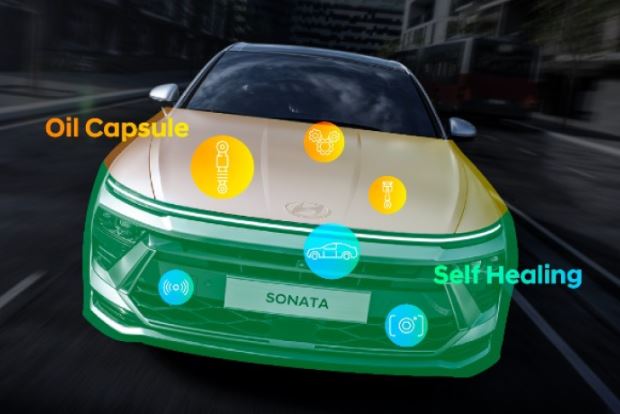Nanotechnological Innovations in Mobility: Hyundai’s Revolutionary Advances Shaping the Future
Hyundai Motor Group, a renowned leader in the automotive industry, has recently achieved a groundbreaking milestone in nanotechnology, introducing six innovative nanotechnologies with the potential to revolutionize the future of mobility. These cutting-edge advancements span various applications, ranging from the advancement of autonomous driving cars to the development of software-defined vehicles, showcasing Hyundai’s commitment to shaping the automotive landscape through technological innovation.
At the forefront of these nanotechnological breakthroughs is the self-healing polymer coating, representing Hyundai’s first foray into this transformative field. This coating boasts a remarkable ability to effortlessly remove scratches and water from cameras and lidar sensors present in self-driving cars. Unlike conventional chemical reactions, this self-healing mechanism involves multiple sets of reactions, enabling a continuous restoration of the car’s detecting devices. This novel technology significantly enhances the accuracy and reliability of self-driving systems, enabling vehicles to identify obstacles and pedestrians on roads more effectively. Impressively, the restoration process takes a mere two hours under ambient temperatures, with slightly longer durations during freezing temperatures below minus 10 degrees Celsius. Hyundai envisions the integration of this groundbreaking technology into mass-produced cars between 2025 and 2026, marking a significant leap forward in creating robust and resilient autonomous vehicles that can navigate roads with heightened precision.
Building upon the success of the self-healing nanotechnology, Hyundai has also unveiled the oil capsule polymer coating technology, showcasing yet another revolutionary development. This innovative coating aims to minimize friction and wear in car parts, surpassing the effectiveness of products offered by other companies by over 50 percent. Hyundai plans to implement this cutting-edge technology onto car chassis, including the drive shaft, by the end of the year. This strategic implementation will significantly reduce the impact of operating devices on vehicles, ultimately leading to improved overall performance and increased longevity of the vehicles.
As part of its commitment to sustainable practices, Hyundai has also made significant strides in developing energy-efficient nanotechnologies, particularly in the realm of transparent solar cells and tandem solar cells. Unlike conventional silicon-based solar cells, Hyundai’s transparent solar cells leverage naturally occurring perovskite, a calcium titanium oxide mineral that exhibits ten times more solar energy absorption capacity. These transparent solar cells will find applications in purpose-built vehicles and eco-friendly cars, serving as a crucial energy source to reduce carbon emissions. In addition to this, Hyundai has introduced tandem solar cells, a revolutionary combination of perovskite solar cells and silicon-based solar energy cells. Tandem solar cells boast higher cell efficiency compared to both conventional silicon cells and perovskite-based cells. Upon application to EVs’ roofs, hoods, and doors, tandem solar cells can achieve a remarkable 30 percent solar cell efficiency, generating 30 watts of electric energy output after absorbing 100 W of solar energy, consequently adding up to 40 kilometers of driving range.
Furthermore, Hyundai’s commitment to enhancing the overall driving experience for passengers is evident in its development of a seat pressure sensor using carbon nanotubes. Renowned for their durability and elasticity, carbon nanotubes enable this sensor to reduce power consumption by up to 50 percent, leading to energy savings of 140 W for EVs by effectively transferring heat to the contact surface of the car seat. The sensor’s capabilities extend further, as it can analyze respiratory rhythms and heart rates, presenting promising applications in the healthcare market.
Hyundai’s determination to address critical environmental issues, such as overheating in vehicles and carbon emissions, is showcased through its transparent radiative cooling film. This innovative film, when applied to car windows, effectively cools down vehicles while simultaneously reducing carbon emissions. Initial tests have demonstrated that vehicles equipped with radiative cooling film windows experienced a temperature reduction of 6.89 degrees Celsius compared to those using low-emissivity films.
The transformative nanotechnologies unveiled by Hyundai are the result of decades of dedicated materials research, exemplifying the company and its affiliate firm Kia’s unwavering commitment to pioneering research projects in advanced materials since the late 1990s. Through strategic leveraging of nanotechnology to enhance vehicle performance, energy efficiency, and passenger experience, Hyundai solidifies its position as a key player shaping the future of mobility. These groundbreaking advancements not only place Hyundai at the forefront of the fast-evolving future mobility market, but also contribute significantly to the automotive industry’s broader goals of sustainability, innovation, and enriched customer experiences. As these nanotechnologies mature and seamlessly integrate into Hyundai’s vehicle lineup, the automotive landscape stands poised for a transformative journey towards a more efficient, eco-friendly, and technologically advanced future. Hyundai’s pioneering spirit and dedication to technological advancement mark an exciting chapter in the evolution of the automotive industry

